Redox Biology ( IF 10.7 ) Pub Date : 2021-10-12 , DOI: 10.1016/j.redox.2021.102164 Austin D Read 1 , Rachel Et Bentley 1 , Stephen L Archer 2 , Kimberly J Dunham-Snary 3

|
Iron-sulfur (Fe–S) clusters are essential cofactors most commonly known for their role mediating electron transfer within the mitochondrial respiratory chain. The Fe–S cluster pathways that function within the respiratory complexes are highly conserved between bacteria and the mitochondria of eukaryotic cells. Within the electron transport chain, Fe–S clusters play a critical role in transporting electrons through Complexes I, II and III to cytochrome c, before subsequent transfer to molecular oxygen. Fe–S clusters are also among the binding sites of classical mitochondrial inhibitors, such as rotenone, and play an important role in the production of mitochondrial reactive oxygen species (ROS). Mitochondrial Fe–S clusters also play a critical role in the pathogenesis of disease. High levels of ROS produced at these sites can cause cell injury or death, however, when produced at low levels can serve as signaling molecules. For example, Ndufs2, a Complex I subunit containing an Fe–S center, N2, has recently been identified as a redox-sensitive oxygen sensor, mediating homeostatic oxygen-sensing in the pulmonary vasculature and carotid body. Fe–S clusters are emerging as transcriptionally-regulated mediators in disease and play a crucial role in normal physiology, offering potential new therapeutic targets for diseases including malaria, diabetes, and cancer.
中文翻译:

线粒体铁硫簇:结构、功能和在血管生物学中的新兴作用
铁硫 (Fe-S) 簇是必不可少的辅助因子,最常见的作用是介导线粒体呼吸链内的电子转移。在呼吸复合物中起作用的 Fe-S 簇通路在细菌和真核细胞的线粒体之间高度保守。在电子传递链中,Fe-S 簇在将电子通过复合物 I、II 和 III 传递到细胞色素c 中起着关键作用, 在随后转移到分子氧之前。Fe-S 簇也是经典线粒体抑制剂(如鱼藤酮)的结合位点之一,并在线粒体活性氧 (ROS) 的产生中发挥重要作用。线粒体 Fe-S 簇在疾病的发病机制中也起着关键作用。在这些部位产生的高水平 ROS 会导致细胞损伤或死亡,然而,当产生低水平的 ROS 时,可以作为信号分子。例如,Ndufs2 是一种包含 Fe-S 中心 N2 的复合 I 亚基,最近被鉴定为氧化还原敏感氧传感器,介导肺血管系统和颈动脉体中的稳态氧传感。Fe-S 簇正在成为疾病中的转录调节介质,并在正常生理学中发挥关键作用,











































 京公网安备 11010802027423号
京公网安备 11010802027423号